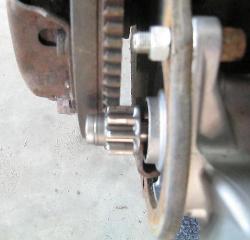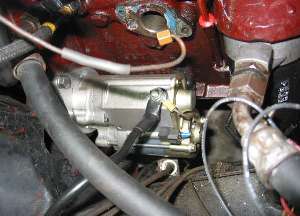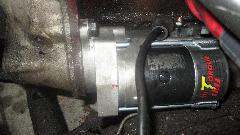The MGA With An Attitude
High Torque STARTER MOTOR - ET-250
When the MG starter motor and battery(s) and connecting cables are in good condition, engine cranking should be no problem with stock equipment, at least in temperatures above 0dF. My MGA now has 350,000 miles, driven in all kinds of weather, and has never had a problem starting in cold weather (above 0dF). If you park the car outside in cold weather and expect it to start when temperatures are below 0dF, or if perchance you tend to leave 20W50 oil in it in below freezing temperatures, then you might consider installing a high torque, high speed gear reduction starter motor.



The most common model is an adaptation of a 1.2 HP Nippondenso starter with an indexable end plate to allow mounting in any orientation. This single model will fit all MG TD, MG TF, MGA, and pre-1968 MGB. (There is a different model available for the late model MGB). It is a direct bolt-in replacement for the original starter motor.
Below left shows the starter mounted with the pinion gear retracted in normal rest position. Below right shows the pinion gear extended in the pre-engaged position where it must go before making electrical contact to run the motor. The beveled ends on the pinion teeth seem to be sufficient to guide the pinion into engagement with the ring gear. The ring gear does not need to be reversed on the flywheel. I have never heard of any case where the pre-engaging pinion gear would hang up on the ring gear before full engagement.


The gear reduction starter can be electrically connected in different ways. When power is applied to the small connector the internal solenoid will push the pinion gear axially into engagement with the flywheel ring gear. Once that push is all the way in an internal contact connects the high current cable to run the motor to spin the engine.

 For the high starter position in post January 1959 production MGA, the motor part of the starter needs to be at 5 o'clock position (right) to fit close to the sump.
For the high starter position in post January 1959 production MGA, the motor part of the starter needs to be at 5 o'clock position (right) to fit close to the sump.

 For pre-1959 production MGA with low starter position, I set it with the motor at the 11 o'clock position (above left) just below the distributor for the motor to clear the chassis frame. I also found in the low starter position that the nose end housing of the HT starter needed to be trimmed slightly on the side to clear the engine block.
For pre-1959 production MGA with low starter position, I set it with the motor at the 11 o'clock position (above left) just below the distributor for the motor to clear the chassis frame. I also found in the low starter position that the nose end housing of the HT starter needed to be trimmed slightly on the side to clear the engine block.
For the MGA the easy way to wire it is to connect the original cable from starter switch to starter onto the screw post of the HT starter, then install a smaller jumper wire from the large terminal to the small terminal. When you pull the starter switch it will first apply power to trigger the internal solenoid, then will draw high current after the gear is engaged. This will still pull high current through the original starter switch.
Another option is to connect both heavy cables onto one terminal of the starter switch, and the secondary cable goes onto the starter screw post. Then run a new low current wire from the second terminal of the starter switch to the small terminal on the starter motor. When you pull the switch to trigger this one, only the small current to trigger the solenoid goes through the starter switch. The high current goes from cable to cable directly to the starter motor. Beware that the larger starter input terminal is a direct connection to the battery and will be always hot with this setup.
There is a third option which is electrically identical to the one immediately above. If your primary battery cable is long enough, you can disconnect it from the starter switch and connect that cable directly to the HT starter. Then connect the secondary heavy current cable from the starter to the starter switch. When finished the fat brown wire (maybe more than one if present) on the starter switch should be on the same switch terminal with the heavy cable, so all of these will be live battery power at all times. Then run a new 16-gauge wire from the second terminal of the starter switch back to the small terminal on the starter motor solenoid. As above, the starter switch will then be switching only the low current needed to kick the starter solenoid.
In all cases the screw post terminal on the starter motor should be covered with the rubber boot when finished, because this is a high power battery connection. If anything metal might be dropped there it could short the hot battery cable to chassis ground, which might result in cable melt-down, electrical fire, or blowing up the battery.
There is some thought that running only low current through the starter switch may extend life of the switch. I'm not so sure about that. My original factory issue switch is still working fine after 55 years and nearly 400,000 miles. I believe the high current sputtering and arcing inside the starter switch actually cleans the contacts when used. If you let the car sit for a long time without use the switch contacts may become corroded. Subsequent use of the switch with high current may clean the contacts again. The question is, if you run only low current through the starter switch, will the contacts still self-clean or will the switch contacts eventually corrode to cause problems? (This is entirely separate from the issue of low quality replacement switches).
You can buy high torque starters from:
BritishStarters.com -
Edge Performance Products -
Moss Motors
They also appear on eBay and at various swap meets from time to time.
At 06:51 AM 8/13/04 -0400, Mark Harris wrote:
"FYI The Japanese High Torque Starter I recently purchased from britishstarters.com (remanufactured in MA) failed within a few weeks of installation. The clutch mechanism went out and the motor turned freely probably 20% of the time I pulled the starter switch. I informed them and they sent a replacement and paid my shipping costs. Others have related similar stories and indicate these units are relatively frail and prone to failure."
On 4/16/2011, John Flannery in Davisburg, Michigan wrote:
"In this particular story you mention Denso but I believe what is pictured is actually a Chinese knockoff. I believe the negative comments from a reader have to do with the Chinese stuff available in the market. The Denso starters typically run their bolts that clamp the motor to the nose casting through the cast aluminum end cap of the motor, not through stampings welded to a stamped motor end cap".
www.densoautoparts.com/starter.php
"I believe TSI in Ohio sells true Denso's".
www.tsimportedautomotive.com/gearreductionstarters.html
On Sep 26, 2018, Malcolm Cox in Napa, CA, USA wrote:
"Starter from Isuzu Trooper 1991 4 cyl drops right in to high starter MGA (not low starter). Used it for years. Eventually the contactor needs clean up".
|






